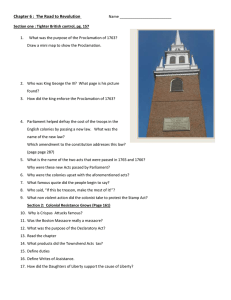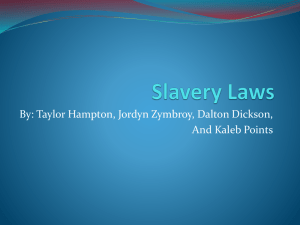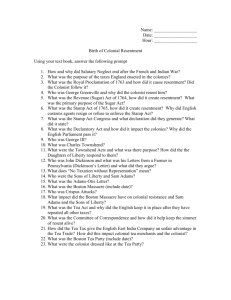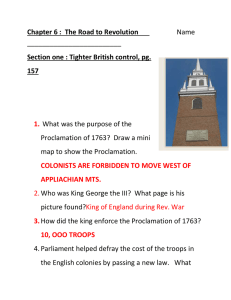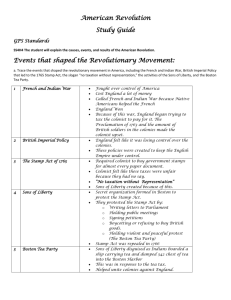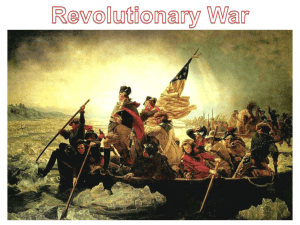Revolution and a New Nation Study Guide Events that led to the
advertisement
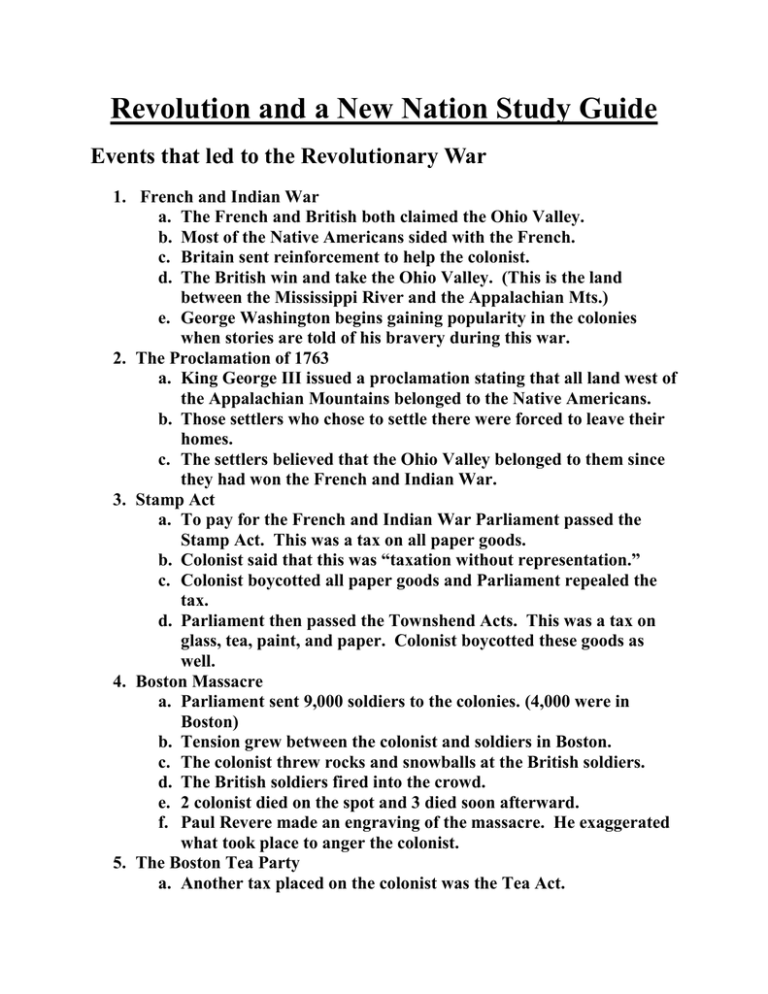
Revolution and a New Nation Study Guide Events that led to the Revolutionary War 1. French and Indian War a. The French and British both claimed the Ohio Valley. b. Most of the Native Americans sided with the French. c. Britain sent reinforcement to help the colonist. d. The British win and take the Ohio Valley. (This is the land between the Mississippi River and the Appalachian Mts.) e. George Washington begins gaining popularity in the colonies when stories are told of his bravery during this war. 2. The Proclamation of 1763 a. King George III issued a proclamation stating that all land west of the Appalachian Mountains belonged to the Native Americans. b. Those settlers who chose to settle there were forced to leave their homes. c. The settlers believed that the Ohio Valley belonged to them since they had won the French and Indian War. 3. Stamp Act a. To pay for the French and Indian War Parliament passed the Stamp Act. This was a tax on all paper goods. b. Colonist said that this was “taxation without representation.” c. Colonist boycotted all paper goods and Parliament repealed the tax. d. Parliament then passed the Townshend Acts. This was a tax on glass, tea, paint, and paper. Colonist boycotted these goods as well. 4. Boston Massacre a. Parliament sent 9,000 soldiers to the colonies. (4,000 were in Boston) b. Tension grew between the colonist and soldiers in Boston. c. The colonist threw rocks and snowballs at the British soldiers. d. The British soldiers fired into the crowd. e. 2 colonist died on the spot and 3 died soon afterward. f. Paul Revere made an engraving of the massacre. He exaggerated what took place to anger the colonist. 5. The Boston Tea Party a. Another tax placed on the colonist was the Tea Act. b. In Boston, the Sons of Liberty dressed as Mohawk Native Americans and dumped 342 chests of tea into the Boston Harbor. c. This act of rebellion made King George and Parliament issue the Coercive Acts. (Intolerable Acts) i. There was a blockade on the Boston Harbor. ii. They stopped the Massachusetts legislature from meeting. iii. The issued the quartering act. This allowed British soldiers to enter and use the homes of the colonist. st 6. The 1 Continental Congress Meeting a. The first meeting of its kind on the North American continent. b. Delegates from the colonies wrote a petition to King George reminding him of their basic rights. c. The delegates gave him about 1 year to respond. If he didn’t they knew this would mean WAR. d. Each colony began to form militias. Paul Revere's Ride Paul Revere was a Son of Liberty who helped in the Boston Tea Party. He is best known for riding on his horse all night to tell the people in the Massachusetts countryside that the British soldiers were coming. This made sure the people were ready for the British attack. That was the start of the American Revolutionary War. Lexington and Concord “The Shot Heard Round the World!”-This was the start of the Revolution. The first battle of the Revolutionary War was fought at Lexington, Massachusetts, on April 19, 1775. The American forces were led by militia captain John Parker. They fought against British troops who were on their way to Concord, Massachusetts. The British troops had been ordered to go to Concord to capture military supplies that the American militia had been storing there. Later, another battle took place in Concord. The battle led to the siege against British troops at Boston. Battle of Bunker Hill The Battle of Bunker Hill took place on June 17, 1775, at Charlestown, Massachusetts, near Boston. The British won the battle, but they lost more soldiers than the colonists did. This battle was part of the Siege of Boston, which took place from April 19, 1775, until March 17, 1776. Declaration of Independence Document that declared independence from Great Britain. Written by Thomas Jefferson Broken up into four main parts: o Preamble o Statement of Rights o Charges against the king o Statement of independence Approved on July 4, 1776 and read publicly Signed on August 2, 1776 and a copy was sent to King George III Articles of Confederation- 1st government as the United States of America. This gave a lot of power to each state but very little to the Federal government. This type of government was very weak, but held the states together during the war.
